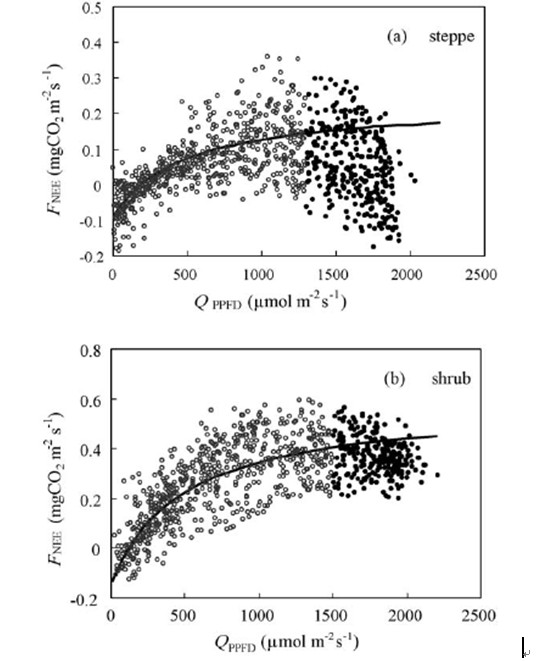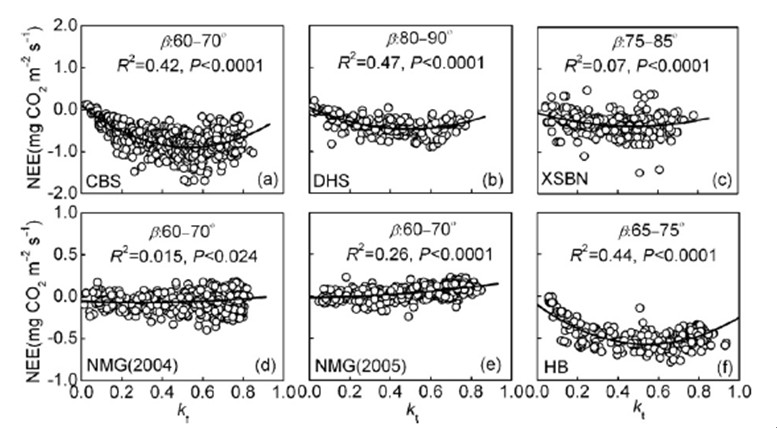| Location: Home>News>Research news |
| Response of Carbon Uptake to Light in Typical Terrestrial Ecosystems of China |
|
|
Solar radiation received on the ground surface drives terrestrial ecosystem carbon cycle. Climate change, anthropogenic activities, change in precipitation pattern and aerosol content in the atmosphere influence cloudiness pattern and regional solar radiation received on the ground surface. Thus, responses of carbon uptake to light in typical terrestrial ecosystems become a key issue for research on the environmental control mechanism of terrestrial ecosystem carbon cycle. Based on measured data of Chinese Terrestrial Ecosystem Flux Research Network (ChinaFLUX), Professor YU Guirui and his colleagues in Synthesis Research Center of Chinese Ecosystem Research Network) of Key Laboratory of Ecosystem Network Observation and Modeling, CAS analyzed the responses of gross ecosystem photosynthesis (GEP) and net ecosystem exchange of carbon dioxide (NEE) to light in typical forest and grassland ecosystems in China. The results show that light saturation phenomenon in response of photosynthesis to light occurs at ecosystem scale, which is often thought occurring at leaf scale. Moreover, “photo-inhibition” phenomenon exists in temperate ecosystem. GEP and NEE of temperate ecosystems decreased under strong light conditions, on the other hand, comparing with clear sky conditions, cloudy sky conditions with clearness index values between 0.4 and 0.6 increased NEE, light use efficiency (LUE), and water use efficiency (WUE) of the ecosystems at temperate ecosystem, such as Changbaishan temperate mixed forest, Inner Mongolia semi-arid L. chinensis steppe, and Haibei alpine frigid Potentilla fruticosa shrub. The phenomenon was also found in subtropical forest ecosystem, such as Dinghushan subtropical evergreen broad-leaved forest. However, LUE of Xishuangbanna tropical rainforest was higher under cloudy than under clear sky conditions, but NEE and WUE did not decrease significantly under clear sky condition. These results indicated that cloudy sky condition is more benefit to increase net carbon uptake of temperate ecosystem. These studies can promote understanding environmental controls of regional terrestrial ecosystem carbon budget, and can improve prediction of effect of changes in climate and aerosol content in the atmosphere on terrestrial ecosystem carbon cycle. These studies are supported by the National Key Research and Development Program. Relative articles list below: 1. Fu Yuling, Yu Guirui, Sun Xiaomin, Li Yingnian, Wen Xuefa, Zhang Leiming, Li Zhengquan, Zhao Liang, Hao Yanbin. Depression of net ecosystem CO2 exchange in semi-arid Leymus chinensis steppe and alpine shrub. Agricultural and Forest Meteorology, 2006, 137:234–244. 2.Zhang Mi, Yu Guirui, Zhang Leiming, Sun Xiaomin, Han Shijie, Yan Junhua. Impact of cloudiness on net ecosystem exchange of carbon dioxide in different types of forest ecosystems in China. Biogeosciences, 2010, 7: 711–722. 3.Zhang Mi, Yu Guirui, Zhuang Jie, Randy Gentry, Fu Yuling, Sun Xiaomin, Zhang Leiming, Wen Xuefa, Wang Qiufeng, Han Shijie, Yan Junhua, Zhang Yiping, Wang Yanfen, Li Yingnian. Effects of cloudiness change on net ecosystem exchange, light use efficiency, and water use efficiency in typical ecosystems of China. Agricultural and Forest Meteorology, 2011, 151: 803–816.
Relationship between net ecosystem CO2 exchange (FNEE) and light intensity at (a) Inner Mongolia semi-arid L. chinensis steppe and (b) Haibei alpine frigid Potentilla fruticosa shrub
Relationship between NEE and the clearness index (kt) for the highest interval of solar elevation angles at (a) Changbaishan temperate mixed forest, (b) Dinghushan subtropical evergreen broad-leaved forest, (c) Xishuangbanna tropical rainforest, (d-e) Inner Mongolia semi-arid L. chinensis steppe and (f) Haibei alpine frigid Potentilla fruticosa shrub |

